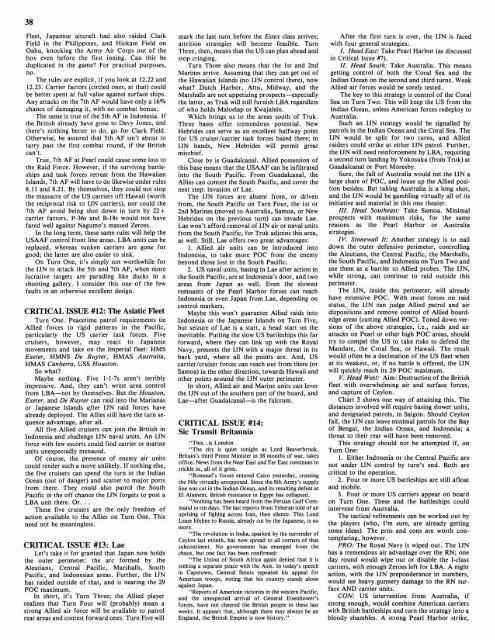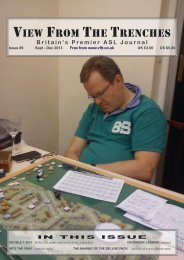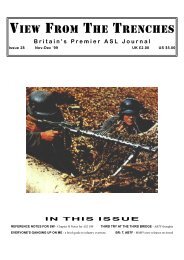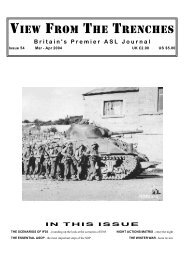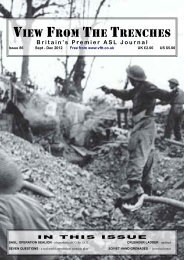18.64MB - View From The Trenches
18.64MB - View From The Trenches
18.64MB - View From The Trenches
- TAGS
- trenches
- www.vftt.co.uk
Create successful ePaper yourself
Turn your PDF publications into a flip-book with our unique Google optimized e-Paper software.
Fleet, Japanese aircraft had also raided Clark<br />
Field in the Philippines, and Hickam Field on<br />
Oahu, knocking the Army Air Corps out of the<br />
box even before the first inning. Can this be<br />
duplicated in the game? For practical purposes,<br />
no.<br />
<strong>The</strong> rules are explicit, if you look at 12.22 and<br />
12.23. Carrier factors (circled ones, at that) could<br />
be better spent at full value against surface ships.<br />
Any attacks on the 7th AF would have only a 16%<br />
chance of damaging it, with no combat bonus.<br />
<strong>The</strong> same is true of the 5th AF in Indonesia. If<br />
the British already have gone to Davy Jones, and<br />
there's nothing better to do, go for Clark Field.<br />
Otherwise, be assured that 5th AF isn't about to<br />
tarry past the first combat round, if the British<br />
can't.<br />
True, 7th AF at Pearl could cause some loss to<br />
the Raid Force. However, if the surviving battle-<br />
ships and task forces retreat from the Hawaiian<br />
Islands, 7th AF will have to do likewise under rules<br />
8.11 and 8.21. By themselves, they could not stop<br />
the massacre of the US carriers off Hawaii (worth<br />
the reciprocal risk to IJN carriers), nor could the<br />
7th AF avoid being shot down in turn by 22+<br />
carrier factors, P-36s and B-18s would not have<br />
fared well against Nagumo's massed Zeroes.<br />
In the long term, these same rules will help the<br />
USAAF control front line areas. LBA units can be<br />
replaced, whereas sunken carriers are gone for<br />
good; the latter are also easier to sink.<br />
On Turn One, it's simply not worthwhile for<br />
the IJN to attack the 5th and 7th AF, when more<br />
lucrative targets are parading like ducks in a<br />
shooting gallery. I consider this one of the few<br />
faults in an otherwise excellent design.<br />
CRITICAL ISSUE #12: <strong>The</strong> Asiatic Fleet<br />
Turn One. Peacetime patrol requirements tie<br />
Allied forces to rigid patterns in the Pacific,<br />
particularly the US carrier task forces. Five<br />
cruisers, however, may react to Japanese<br />
movements and take on the Imperial fleet: HMS<br />
Exeter, HMNS De Ruyter, HMAS Australia,<br />
HMAS Canberra, USS Houston.<br />
So what?<br />
Maybe nothing. Five 1-1-7s aren't terribly<br />
impressive. And, they can't wrest area control<br />
from LBA-not by themselves. But the Houston,<br />
Exeter, and De Ruyter can raid into the Marianas<br />
or Japanese Islands after IJN raid forces have<br />
already deployed. <strong>The</strong> Allies still have the turn se-<br />
quence advantage, after all.<br />
All five Allied cruisers can join the British in<br />
Indonesia and challenge IJN naval units. An IJN<br />
force with few escorts could find carrier or marine<br />
units unexpectedly menaced.<br />
Of course, the presence of enemy air units<br />
could render such a move unlikely. If nothing else,<br />
the five cruisers can spend the turn in the Indian<br />
Ocean (out of danger) and scatter to major ports<br />
from there. <strong>The</strong>y could also patrol the South<br />
Pacific in the off chance the IJN forgets to post a<br />
LBA unit there. Or. . .<br />
<strong>The</strong>se five cruisers are the only freedom of<br />
action available to the Allies on Turn One. This<br />
need not be meaningless.<br />
CRITICAL ISSUE #13: Lae<br />
Let's take it for granted that Japan now holds<br />
the outer perimeter: the arc formed by the<br />
Aleutians, Central Pacific, Marshalls, South<br />
Pacific, and Indonesian areas. Further, the IJN<br />
has raided outside of that. and is nearing - the 29<br />
POC maximum.<br />
In short, it's Turn Three; the Allied player<br />
realizes that Turn Four will (probably) mean a<br />
strong Allied air force will be available to patrol<br />
rear areas and contest forward ones. Turn Five will<br />
mark the last turn before the Essex class arrives;<br />
attrition strategies will become feasible. Turn<br />
Three, then, means that the US can plan ahead and<br />
stop cringing.<br />
Turn Three also means that the 1st and 2nd<br />
Marines arrive. Assuming that they can get out of<br />
the Hawaiian Islands (no IJN control there), now<br />
what? Dutch Harbor, Attu, Midway, and the<br />
Marshalls are not appetizing prospects-especially<br />
the latter, as Truk will still furnish LBA regardless<br />
of who holds Maloelap or Kwajalein.<br />
Which brings us to the areas south of Truk.<br />
Three bases offer tremendous potential. New<br />
Hebrides can serve as an excellent halfway point<br />
for US cruiser/carrier task forces based there; in<br />
IJN hands, New Hebrides will permit great<br />
mischief.<br />
Close by is Guadalcanal. Allied possession of<br />
this base means that the USAAF can be infiltrated<br />
into the South Pacific. <strong>From</strong> Guadalcanal, the<br />
Allies can contest the South Pacific, and cover the<br />
next step: invasion of Lae.<br />
<strong>The</strong> IJN forces are absent from, or driven<br />
from, the South Pacific on Turn Four, the 1st or<br />
2nd Marines (moved to Australia, Samoa, or New<br />
Hebrides on the previous turn) can invade Lae.<br />
Lae won't afford removal of IJN air or naval units<br />
from the South Pacific, for Truk adjoins this area,<br />
as well. Still, Lae offers two great advantages:<br />
1. Allied air units can be introduced into<br />
Indonesia, to take more POC from the enemy<br />
beyond those lost in the South Pacific.<br />
2. US naval units, basing in Lae after action in<br />
the South Pacific, are at Indonesia's door, and two<br />
areas from Japan as well. Even the slowest<br />
remnants of the Pearl Harbor forces can reach<br />
Indonesia or even Japan from Lae, depending on<br />
control markers.<br />
Maybe this won't guarantee Allied raids into<br />
Indonesia or the Japanese Islands on Turn Five,<br />
but seizure of Lae is a start, a head start on the<br />
inevitable. Putting the slow US battleships this far<br />
forward, where they can link up with the Royal<br />
Navy, presents the IJN with a major threat in its<br />
back yard, where all the points are. And, US<br />
carrier/cruiser forces can reach out from there (or<br />
Samoa) in the other direction, towards Hawaii and<br />
other points around the IJN outer perimeter.<br />
In short, Allied air and Marine units can lever<br />
the IJN out of the southern part of the board, and<br />
Lae-after Guadalcanal-is the fulcrum.<br />
CRITICAL ISSUE #14:<br />
Sic Transit Britannia<br />
"This ... is London<br />
"<strong>The</strong> city is quiet tonight as Lord Beaverbrook,<br />
Britain's third Prime Minister in 38 months of war, takes<br />
office. News from the Near East and Far East continues to<br />
trickle in, all of it grim.<br />
"Rommel's forces entered Cairo yesterday, crossing<br />
the Nile virtually unopposed. Since the 8th Army's supply<br />
line was cut in the Indian Ocean, and its resulting defeat at<br />
El Alamein, British resistance in Egypt has collapsed.<br />
"Nothing has been heard from the Persian Gulf Com-<br />
mand in ten days. <strong>The</strong> last reports from Teheran told of an<br />
uprising of fighing across Iran, then silence. This Lend<br />
Lease lifeline to Russia, already cut by the Japanese, is no<br />
more.<br />
"<strong>The</strong> revolution in India, sparked by the surrender of<br />
Ceylon last month, has now spread to all corners of that<br />
subcontinent. No government has emerged from the<br />
chaos, but one fact has been confirmed:<br />
"<strong>The</strong> Union of South Africa again denied that it is<br />
seeking a separate peace with the Axis. In today's speech<br />
in Capetown, General Smuts repeated his appeal for<br />
American troops, noting that his country stands alone<br />
against Japan.<br />
"Reports of American victories in the western Pacific,<br />
and the unexpected arrival of General Eisenhower's<br />
forces, have not cheered the British people in these last<br />
weeks. It appears that, although there may always be an<br />
England, the British Empire is now history."<br />
After the first turn is over, the IJN is faced<br />
with four general strategies:<br />
I. Head East: Take Pearl Harbor (as discussed<br />
in Critical Issue K').<br />
11. Head South: Take Australia. This means<br />
getting control of both the Coral Sea and the<br />
Indian Ocean on the second and third turns. Weak<br />
Allied air forces would be sorely tested.<br />
<strong>The</strong> key to this strategy is control of the Coral<br />
Sea on Turn Two. This will keep the US from the<br />
Indian Ocean, unless American forces redeploy to<br />
Australia.<br />
Such an IJN strategy would be signalled by<br />
patrols in the Indian Ocean and the Coral Sea. <strong>The</strong><br />
IJN would be split for two turns, and Allied<br />
raiders could strike at either IJN patrol. Further,<br />
the IJN will need reinforcement by LBA, requiring<br />
a second turn landing by Yokosuka (from Truk) at<br />
Guadalcanal or Port Moresby.<br />
Sure, the fall of Australia would net the IJN a<br />
large share of POC, and louse up the Allied posi-<br />
tion besides. But taking Australia is a long shot,<br />
and the IJN would be gambling virtually all of its<br />
initiative and material in this one theater.<br />
IZZ. Head Southeast: Take Samoa. Minimal<br />
prospects with maximum risks, for the same<br />
reasons as the Pearl Harbor or Australia<br />
strategies.<br />
ZV. Stonewall It: Another strategy is to nail<br />
down the outer defensive perimeter, controlling<br />
the Aleutians, the Central Pacific, the Marshalls,<br />
the South Pacific, and Indonesia on Turn Two and<br />
use them as a barrier to Allied probes. <strong>The</strong> IJN,<br />
while strong, can continue to raid outside this<br />
perimeter.<br />
<strong>The</strong> IJN, inside this perimeter, will already<br />
have extensive POC. With most forces on raid<br />
status, the IJN can judge Allied patrol and air<br />
dispositions and remove control of Allied board-<br />
edge areas (cutting Allied POC). Toned down ver-<br />
sions of the above strategies, i.e., raids and air<br />
attacks on Pearl or other high POC areas, should<br />
try to compel the US to take risks to defend the<br />
Mandate, the Coral Sea, or Hawaii. <strong>The</strong> result<br />
would often be a decimation of the US fleet when<br />
at its weakest, or, if no battle is offered, the IJN<br />
will quickly reach its 29 POC maximum.<br />
V. Head West: Aim: Destruction of the British<br />
fleet with overwhelming air and surface forces,<br />
and capture of Ceylon.<br />
Chart 3 shows one way of attaining this. <strong>The</strong><br />
distances involved will require basing slower units,<br />
and designated patrols, in Saigon. Should Ceylon<br />
fall, the IJN can leave minimal patrols for the Bay<br />
of Bengal, the Indian Ocean, and Indonesia; a<br />
threat to their rear will have been removed.<br />
This strategy should not be attempted if, on<br />
Turn One:<br />
1. Either Indonesia or the Central Pacific are<br />
not under IJN control by turn's end. Both are<br />
critical to the operation.<br />
2. Four or more US battleships are still afloat<br />
and mobile.<br />
3. Four or more US carriers appear on board<br />
on Turn One. <strong>The</strong>se and the battleships could<br />
intervene from Australia.<br />
<strong>The</strong> tactical refinements can be worked out by<br />
the players (who, I'm sure, are already getting<br />
some ideas). <strong>The</strong> pros and cons are worth con-<br />
templating, however.<br />
PRO: <strong>The</strong> Royal Navy is wiped out. <strong>The</strong> IJN<br />
has a tremendous air advantage over the RN; one<br />
day round would wipe out or disable the I-class<br />
carriers, with enough Zeroes left for LBA. A night<br />
action, with the IJN preponderance in numbers,<br />
would see heavy gunnery damage to the RN sur-<br />
face AND carrier units.<br />
CON: US intervention from Australia, if<br />
strong enough, would combine American carriers<br />
with British battleships and turn the strategy into a<br />
bloody shambles. A strong Pearl Harbor strike,


